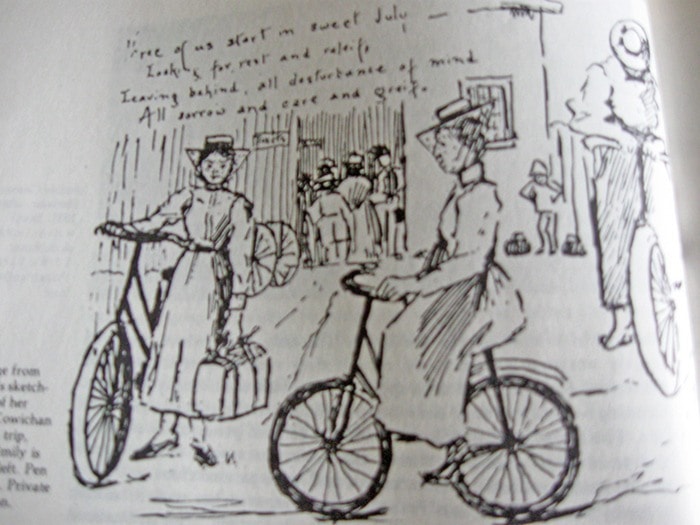If you can’t hitch a ride any other way, use your bicycle. That’s just what the young woman named Emily Carr did “back in the day” (as the saying now goes).
In the early days of settlement and long before paved highways existed in these parts the normal mode of transport was walking/hiking, using horse and buggy via a rough trail or boating upriver from Duncan to Cowichan Lake. There was also the bicycle, although not a popular choice, it was an option for those very few that were hale and hearty as well as adventurous.
In 1895, a budding young artist and poet named Emily Carr, packed up her sketch book and pencil, a few provisions and with a close friend, took the train from Victoria to Duncan. It was there that they began their bicycling trip to Cowichan Lake.
The young women were dressed in clothing of that era — long dresses and wide brimmed hats that featured netting, perhaps to ward off mosquitoes. To imagine the trials and tribulations of bicycle travel back then is almost unimaginable today. Described as a “bumpy coach road,” by Carr, the “road” was actually a rough trail.
The women were faced with the threat of rain; thick, dark forests with the chance of animals lurking round every tree and curve and countless obstacles like fallen trees blocking their way. They pedalled mile after mile in these conditions in what Carr described as a fearful trip through a dense forest of “tall . . . sombre trees, and a silence that was gruesome.”
Upon arrival at the Riverside Inn — which Emily incorrectly referred to in her daily journal as the Cowichan Inn — the young women were met by dark stands of timber everywhere but for the clearing that constituted the settlement (that later became the Town of Lake Cowichan). From her second story room at the inn, she “watched fishes jump and grasses quiver” (her poetic description of her view of the Cowichan River). Her description of the inn itself left something to be desired. She described her room, which was made of planks, as dreary. During her three nights there, she spent little time sleeping at night and instead of counting sheep, it seems she spent hours counting the spiders on the ceiling.
It seems that her interest in the accommodation, the “awesome” forests and river, were perhaps at best, luke warm. The pair spent time cycling the limited roads and trails that led to and from the inn. There is no doubt that, while here, Carr sketched the inn and another building that could have been a store or the barn at nearby McCallum’s Landing. Her sketch book revealed what seems to have been a very limited interest in recording, through poetry and sketches, the desolate place she found.
Emily Carr was to become one of Canada’s most distinguished artists and an icon in British Columbia where she was born (1871) and died (1945) and did most of her work. Today, several of her works are on permanent loan to the Vancouver Art Gallery. She produced countless water colours of her chosen subjects, the forests and scenes of the West Coast and of the Coast Salish peoples of southern Vancouver Island.
